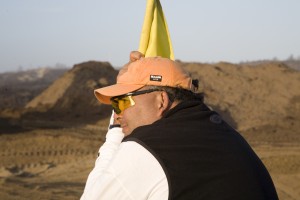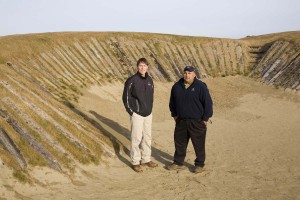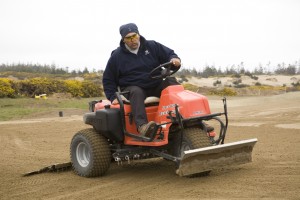 Jim Urbina is a co-designer of Old Macdonald, a billing he shares with Tom Doak. The two worked together on many previous projects, including Pacific Dunes, where Tom was listed as the architect and Jim was the project supervisor — though he often pushed Tom with design ideas. Resort owner Mike Keiser describesJ im Urbina as “one of those dirt guys who can do anything – and he’s also a natural showman and storyteller.” Dark-eyed, olive-skinned, and animated, Jim is passionate in his beliefs about golf course design, and he was into Old Mac all the way, blood, guts, and feathers. He basically lived on-site while the construction was underway, working closely with Ken Nice, the Director of Agronomy at the resort. In late April 2009, as the course was nearing completion, I spent the best part of a morning with the two of them, walking several holes and learning about their views of fescue, strategic design, and power spots.
Jim Urbina is a co-designer of Old Macdonald, a billing he shares with Tom Doak. The two worked together on many previous projects, including Pacific Dunes, where Tom was listed as the architect and Jim was the project supervisor — though he often pushed Tom with design ideas. Resort owner Mike Keiser describesJ im Urbina as “one of those dirt guys who can do anything – and he’s also a natural showman and storyteller.” Dark-eyed, olive-skinned, and animated, Jim is passionate in his beliefs about golf course design, and he was into Old Mac all the way, blood, guts, and feathers. He basically lived on-site while the construction was underway, working closely with Ken Nice, the Director of Agronomy at the resort. In late April 2009, as the course was nearing completion, I spent the best part of a morning with the two of them, walking several holes and learning about their views of fescue, strategic design, and power spots.
What follows is an excerpt from the revised edition of “Dream Golf,” published in June by Algonquin Press.
In late April 2009, Jim Urbina was at Bandon Dunes to oversee the last stages of the construction of Old Macdonald. Ten holes were now open to resort guests for preview loops, and the other eight holes were in various stages of completion. No. 17, the long par 5 that had been the subject of so much discussion in November, was fully shaped and fine-tuned, its alternate fairways divided by a nest of bunkers and its green defended by yet another bold bunker faced with railroad ties.
On a cool spring morning, Jim and Ken Nice, the Director of Agronomy at Bandon Dunes, were watching the crew shoot the hydroseed onto the green and the green surrounds. Most of the 590-yard hole looked unnaturally smooth and shaven, like a giant patient being prepared for surgery. Where the hydroseed was being applied, the soil was a weird aquamarine color, a chemical color like a sterilizing disinfectant. This color would vanish in a couple of days, but it had the immediate benefit of showing exactly where the seed has been applied. The crew of a dozen moved slowly and carefully across the just-raked green, the heavy hose – the size of a fire hose – hoisted onto their shoulders. They didn’t want that hose dragging across the soil, and they were trying not to leave any footprints.
Just off the green, Jim inspected the native plants, huckleberry and knickaknick, that had been tucked into the soil. “I want rough with soul,” he said to Ken. “You’ve got to give the rough some character.” These plants really wouldn’t come into play for a golfer. For that matter, most of the rough at Old Macdonald was safely removed from the places where a golf ball would end up. But Jim kept going on about “rough with soul” as a way of providing texture and a touch of wildness to a course that was otherwise going to present an unbroken surface of fescue.
 There was an obvious sense of camraderie between Jim and Ken. Their relationship had begun back in 2000 when Ken was at Pacific Dunes, overseeing the grow-in for that course; he later moved to Bandon Trails, moving up to become the chief superintendent in 2008. A tall, thoughtful man who played college basketball, Ken had always been a recreational golfer. The courses he grew up playing, though, were nothing like the courses that really sparked his imagination — the courses he saw on television when he watched the British Open. He ccouldn’t explain why, but he loved those shaggy, rumpled, seaside courses. Watching the crazy rolls and bounces of the ball, the shots that players hit into the wind and along the ground, he decided that he wanted to work in golf, and specifically on a links golf course. In what seems like a meant-to-be-career pattern, he ended up at Bandon Dunes.
There was an obvious sense of camraderie between Jim and Ken. Their relationship had begun back in 2000 when Ken was at Pacific Dunes, overseeing the grow-in for that course; he later moved to Bandon Trails, moving up to become the chief superintendent in 2008. A tall, thoughtful man who played college basketball, Ken had always been a recreational golfer. The courses he grew up playing, though, were nothing like the courses that really sparked his imagination — the courses he saw on television when he watched the British Open. He ccouldn’t explain why, but he loved those shaggy, rumpled, seaside courses. Watching the crazy rolls and bounces of the ball, the shots that players hit into the wind and along the ground, he decided that he wanted to work in golf, and specifically on a links golf course. In what seems like a meant-to-be-career pattern, he ended up at Bandon Dunes.
He is now a leading member of “the fescue community” of superintendents who like to see their courses cloaked with fescue, not bent. Fescue, of course, is the natural grass of the links; it is a round-bladed grasss, and bent is flat-bladed. In terms of their playing qualities, bent grass is like Velcro; fescue is like a surface slicked with Vaseline. On a course like Old Macdonald, where the golfer will need a full array of low, running shots, bent simply wouldn’t work.
In fact, Old Mac was being seeded with 100% fescue. On the other courses at Bandon Dunes, the seeding had been applied as a blend, with the amount of bent grass reduced for each successive course. At Pacific Dunes, the blend had been 90-10, and at Bandon Trails 95-5. At Old Mac, Ken was ready to eliminate the bent and go all-in with fescue. “Most places can’t do that,” he said, “but we have the right climate. Fescue works here. It’s just better all around – it needs less water and practically no herbicides or fungicides. Our chemical budget on these courses is ridiculous, about 10% of what they spend at a course with conventional grasses and methods. “
From Jim’s point of view, the fescue provides not only the right playing surface but also the seamless look he wanted. Most golf courses are anything but seamless. They are striated with lines created by mowing patterns –fairway lines, rough cuts, intermediate cuts, collar cuts, trim cuts. There are lines everywhere, and the green sits there like a bull’s eye in a target, with concentric circles all around it. Wasn’t a seamless look going to seem radical to many golfers? “Radical isn’t a word we use,” Jim said, “but the fescue is different, that’s for sure. We started doing this at Pacific, and we’re taking it even farther here at Old Mac. We want the greens to blend in so completely that they almost disappear. The only way you’ll know it’s a green is because of the flag. The fescue is the only thing out here, and everything just flows into everything else. You don’t see those lines and edges. The course isn’t constantly giving you directions about where to hit the ball or what kind of shot you should play. It’s all one playing field. Everything out here goes against the conventional wisdom.”
 By this point, we’d wandered over to nearby second tee. Jim and Ken were taking a walk-around to see how the grass was growing in, and Jim wanted to identify a few other places where he thought the rough could use more soul. The pace was deliberate, with Jim favoring the knee that was pretty much destroyed by an old football injury, and Ken looking carefully for the first reddish, almost microscopic shoots of fescue. “That’s what a turf guy likes to see,” he said, pointing out how evenly the specks were spread.
By this point, we’d wandered over to nearby second tee. Jim and Ken were taking a walk-around to see how the grass was growing in, and Jim wanted to identify a few other places where he thought the rough could use more soul. The pace was deliberate, with Jim favoring the knee that was pretty much destroyed by an old football injury, and Ken looking carefully for the first reddish, almost microscopic shoots of fescue. “That’s what a turf guy likes to see,” he said, pointing out how evenly the specks were spread.
The second hole is a par 3, an Eden hole, modeled after the Edens at National and St. Andrews. The green is perched high, but the most arresting feature of the hole is a sod-faced bunker – a revet, in Jim’s lingo. “So, is that a bold bunker?” he asked, after reminding me that Macdonald prescribed six bold bunkers on a course. He talked about the variations of bunkering at Old Mac, where they’d used everything from natural blowouts to sleepered bunkers to grass-faced bunkers to revets. “We weren’t really thinking we had to do something so different from Pacific, but one day Brian Slawnik shaped a bunker that had a grass face and we said, ‘That looks neat.’ So we went with it.”
This revet on No. 2 was almost a command performance. The original Eden hole at St. Andrews is guarded by the Strath bunker, one of the most renowned bunkers in golf. With steep pitched green, the Eden River directly behind, and the Strath bunker in front, the hole has humbled many great players, including the young Bobby Jones; the Eden is where he famously tore up his scorecard and left the course in a fit of temper.
“It’s not a very big bunker,” Jim was saying, “and it’s even smaller than it looks from here. If Ken was standing down there, if you had anything to give you perspective, you’d see how small it was. When you stand here on the tee, though, it’s a scary bunker, and you’re thinking you’d better avoid it. The Strath bunker.”
He drew out that Strath, enjoying the Scottish sound of it, relishing the thought that the bunker had a new incarnation here at Bandon.
En route to the third tee, Jim told an anecdote about working with Jack Nicklaus at Sebonac. Nicklaus was staying next door at National Golf Links, and one morning Jim picked him up to drive him to work. As they drove out of National, Nicklaus asked him what he liked so much about the course. “I don’t know how much Jack liked it,” Jim said, “but he knew how I felt about it. I told him I loved National because it’s so unpredictable. Every time I go there, there’s something new to learn. I said, ‘Jack, what I like about it is the mystery. It’s a course you’re never going to figure out.’”
Mystery. That seemed to be the right topic as we stood on the third tee and looked at the dead cedar silhouetted against the sky. The ghost tree. I’d heard from Grant Rogers that Jim had once taken him around Pacific Dunes, pointing out the “power spots,” so I asked him if this was one of the power spots on Old Mac. “I know it’s a power spot,” he said, laughing. “Absolutely. I almost got hit by lightning here. I felt the power.”
Jim may be a “dirt guy,” but it turns out that he has respect for intangible forces, too. He traces this back to his experience at Apache Stronghold, a course that Renaissance built in San Carlos, Arizona, near the Superstition Mountains. A medicine man, says Jim, initiated him into the mysteries and legends of the place, reputed to be a mystical haven where Apaches could walk invisible to their enemies. The medicine man also showed him where the spirits entered and exited the stronghold. Ever since, he had carried a string of mojo beads on all his jobs. The mojo beads and the Red Book, Macdonald’s book, were his inspirations.
“I don’t talk about this much,” Jim said, “but anyone who spends time on a site like this starts to have feelings about it. It’s not all the same. Different spots out here have different vibes. I try to pay attention to them, that’s all.”
 We circled through a set of interior holes, a Redan and the Leven hole, a short par 4, before climbing up a hill to pause for a while behind the 14th green. This is another high spot on the course, and we had views that spread for miles in all directions. To the north, we could see some of the holes on the Sheep Ranch, with tiny yellow flags marking the greens. Straight in front of us, groups were playing along the fairways and through the sandhills at Pacific Dunes. Altogether, the golf filled about four miles of coastline that had once been an impassable thicket of gorse. Jim Urbina had been instrumental in the making of many of these golf holes. “When I look around now,” he said, “I almost don’t believe it. I think, Wow. We did all that. Tom, and Ken, the whole crew – we did that. We changed this place.”
We circled through a set of interior holes, a Redan and the Leven hole, a short par 4, before climbing up a hill to pause for a while behind the 14th green. This is another high spot on the course, and we had views that spread for miles in all directions. To the north, we could see some of the holes on the Sheep Ranch, with tiny yellow flags marking the greens. Straight in front of us, groups were playing along the fairways and through the sandhills at Pacific Dunes. Altogether, the golf filled about four miles of coastline that had once been an impassable thicket of gorse. Jim Urbina had been instrumental in the making of many of these golf holes. “When I look around now,” he said, “I almost don’t believe it. I think, Wow. We did all that. Tom, and Ken, the whole crew – we did that. We changed this place.”
Ken nodded, watching a foursome hit their approach shots onto the green. When one ball landed near the flag, he said, “I just love that thunk the ball makes when it hits a firm green.”
There were still a couple of holes to check out. We walked down to the 15th tee and back up to the green with another ocean view, but Jim and Ken weren’t looking at the Pacific. They were laughing at the fist-sized rocks that had appeared in the bunker behind the green. “Brian (Slawnik) was up here for a week, working on this bunker, and the last time I looked it was perfect. Pure sand. Now look at it.” It was almost as if he’d planned this demonstration to show me that the land has a will of its own. Ken said that an old haul road ran through this area, and shrugged. “It’s just the kind of situation you work with. You can’t see the road now, but it’s under there, somewhere, and it’s gonna show up now and then.”
On to No. 16, the Alps hole, where the major hazard – the big hill that serves as the eponymous Alps — was surmounted by a small, glistening orb. It looked like a cosmic talisman but proved on closer inspection to be a bowling ball impaled on a stake. “We’ve got to get rid of that,” Jim said, pointing out how the hole would play. The approach to the green would be blind, but a less-than-perfect shot over the left side of the Alps had a chance of running down close to the green. A weak approach to the right would finish in another sleepered bunker. The player who didn’t want a blind shot and could smack a long drive down the far right side of the fairway would get a glimpse of the green. “Look at that green,” Jim said. “When we came out here after the gorse fire, it was just sitting there waiting for us, a sweet little private bowl, with these hills surrounding it – how could we not use that?”
Another power spot? I asked.
His dark eyes gleamed and he just nodded.
